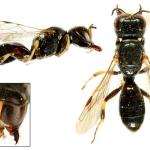Crossocerus aphidium misident.; Crabro cloevorax (NIELSON,1901); Crabro clypearis (SCHENCK,1857); Crabro geniculatus (SHUCKARD,1837)
A small black solitary wasp with a yellow clypeus in both sexes. Identification keys are given in Yeo & Corbet (1995), Lomholdt (1984) and Richards (1980).
There are scattered records from across much of Britain, northwards to central Scotland. Overseas, recorded from northern and central Europe, Central Asia and Japan (Bitsch & Leclerq 1993).
Listed as a Notable B species in Falk (1991), now known as Nationally Scarce (Nb).
Associated with wetlands and the margins of cleaner streams and rivers.
Recorded from May to August.
Nest burrows are stocked with small mayflies (Ephemeroptera), usually from the family Baetidae (Lomholdt 1984), though Richards (1980) suggests that, “very rarely”, small Diptera may be taken.
Nests are in cavities in dead wood; the tunnel system may be simple or branched. A single nest may contain up to 16 individual cells, with 4-7 prey items being placed in each cell. The legs and sometimes the head of individual mayflies may be amputated before they are placed in a cell. The wasp tends to collect and store several prey items in the burrow before dividing them into batches in individual cells (Lomholdt 1984).
None recorded.
None recorded.
2009


